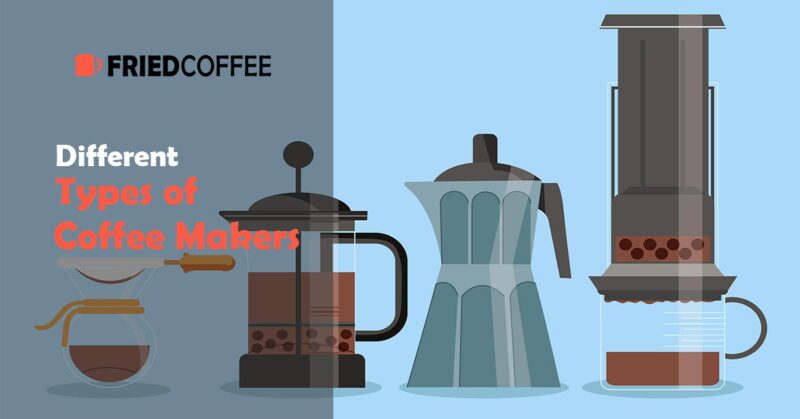
Coffee may be a normal beverage to some people. However, for coffee lovers, it is an emotion, an addiction, or a culture. Through the ages, the taste and mechanism of preparing coffee have evolved in multiple ways. The most common types of coffee makers use any one of the three main brewing methods namely dripping, steeping, and pressure. These have made the task even trickier.
Additionally, coffee makers have are evolving gradually with more modern techniques, therefore, it is confusing to select the right one. The mechanisms, as well as the positive and negative sides, are worth mentioning to understand well. After going through this article, we are confident, that you will be able to select your favorite kind of coffee maker without any hesitation.
Different Types of Coffee Makers
Auto-Drip Coffee Maker
An Auto-Drip coffee brewer uses the most common technique to brew a coffee. These common types of coffee makers are suitable for daily use. The technique is somewhat similar to the percolator. The only notable difference is the texture of the coffee. In other words, the coffee is comparatively smoother. Furthermore, it is not overcooked or bitter, but perfect in taste.

Working Mechanism
There are a reservoir and a filter. The reservoir is for cold water whereas the filter is for ground coffee. The heating element in the coffee maker heats the water and forces it to move upwards. As a result, the hot water drips on the filter filled with ground coffee through the showerhead. Consequently, you accumulate the brewed coffee in the glass carafe.
The glass carafe has an optional thermal plate beneath it to keep the coffee warm. Some come with thermal carafe if they don’t have a thermal plate.
Pros
- It keeps the coffee hot for a longer time.
- The total process is automatic, so there is no need to brew coffee traditionally.
- The system has simple and easy technology.
Cons
- The thermal plate burns the coffee imparting a bitter taste if kept for long.
- The settings are pre-programmed, therefore, there will be certain limitations of each brand.
Pour-Over Coffee Maker

A Pour-Over Coffee Maker is a gentle way to make a coffee. The traditional ones used to sit on a single cup and make a single cup of filter coffee. However, the newer versions can make more than a cup.
Working Mechanism
There is a cone-shaped funnel with a filter. The filter is the place for medium-coarse ground coffee. The twist is adding the hot boiling water. A properly trained barista pours water in batches to make a fine concoction. The first pour blooms the coffee; whereas the second one completely brews them.
Pros
- These types of coffee makers need only two things- hot water and a filter with coffee.
- It prepares a gentle full-bodied cup of coffee.
Cons
- The process is time taking.
- The volume and number of pours may not be perfect every time.
Espresso Coffee Maker
Espresso is the king of coffee for coffee lovers. These common types of coffee makers use the technique of pressure. Espresso Coffee Makers make concentrated coffee in comparison to drip coffee.

Working Mechanism
There are several types of Espresso machines that have evolved till now. They can be manual, automatic, semi-automatic, or even super-automatic. Overall, the working mechanism is the same for all. The hot water runs through the pressed ground coffee under high pressure.
In the manual ones, the barista controls the total machine including the amount of pressure applied. On the other hand, the super-automatic ones run without any human help. These are well programmed and very easy to use.
Pros
- The automatic and super-automatic ones are very easy to use.
- These machines often have a milk frother.
- Espresso is the base of almost all other coffees like Cappuccinos, Lattes, Mochas, Americanos. Therefore, Espresso Coffee Machine is a good purchase.
Cons
- Espresso machines are expensive.
- Maintenance is difficult and tiresome to some extent.
- You may have to learn about time, temperature and pressure management in some cases.
AeroPress
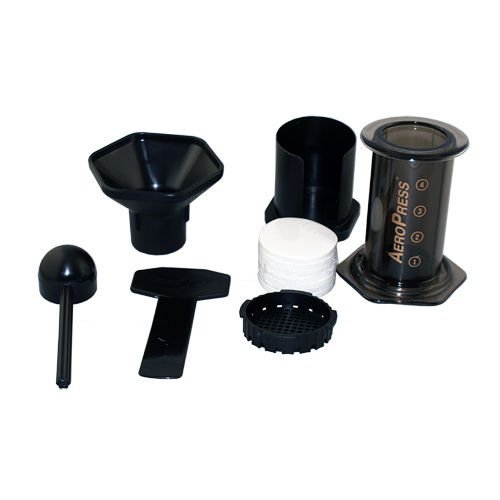
The AeroPress coffee maker uses air pressure to make the coffee. It is very popular among the crowd because it is easy to maintain. The specialty lies in making espresso and Americanos. However, the technique is more similar to drip coffee, but the result is almost as good as the espresso machine. In addition, if coffee grounds are brewed for 1 minute, it can make a good and tantalizing cold brew coffee.
Working Mechanism
Generally, an AeroPress Coffee Maker comes with a number of parts like a scoop, funnel, plunger, and microfilters. Firstly, place the base on a sturdy Mug. Pour one scoop of finely ground coffee to the base of the maker. Level the coffee ground. Add heated water as per your requirement (preferably at 1750 F or 800 C) into the base. Stir it for 10 seconds. Then, press down gently using the plunger to brew a delectable cup of coffee.
Pros
- The process is very quick and easy.
- Good for people who love strong coffee.
- It is portable.
Cons
- There are many small parts to be managed carefully.
- Optimum pressure is required. Otherwise, the taste of the coffee may not come out as required.
French Press Coffee Maker
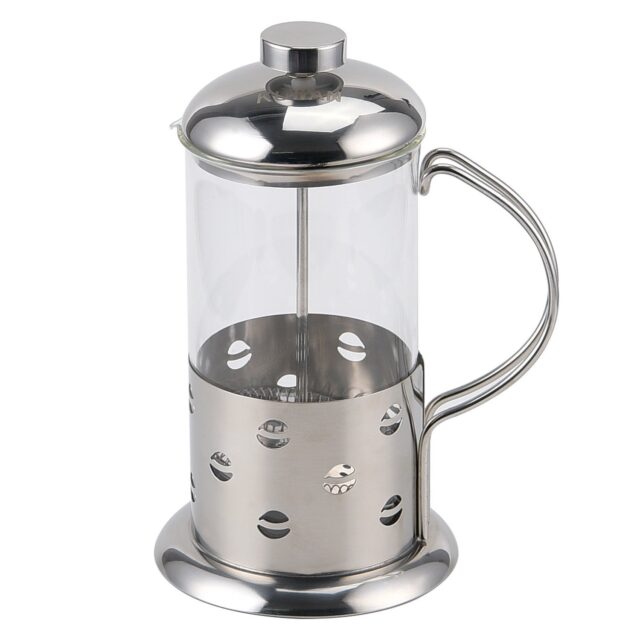
A French Press Coffee maker makes rich and flavorful coffee. Both AeroPress and French Press are based on pressure management, but they are very much different from each other. A French Press maker can make both lighter and stronger brew. Therefore, you can make a coffee of your taste.
Working Mechanism
For a French Press, you have to use coarse / medium-ground coffee. Add the coffee to the carafe. Pour boiled or hot water into the carafe and cover it with a lid. Allow it to steep. The preferable time is 4 minutes. However, in case you need stronger coffee, you can keep it for few more minutes. Now, gently push down the piston very slowly, so that the coffee grounds move downwards. Pour the coffee into a mug.
Pros
- It is space-saving and you can accommodate it on a small counter.
- The French Press is easy to use and affordable.
- You can control the brew time. Hence, it gives an exceptional taste to the coffee.
Cons
- Washing the piston filter can be messy sometimes.
- Coffee cools down quickly if you brew it for more time.
Stovetop Coffee Maker or Moka Pot
A Moka pot is a traditional coffee maker that transformed the culture of coffee in Italy. Often known as Stovetop Coffee Maker, the Moka pot makes coffee that is almost similar to espresso. However, the brew is not espresso since the pressure required for espresso is not optimum in Moka pot. Nonetheless, the dark brew can form an excellent base for Lattes and Cappuccinos.

Working Mechanism
There are two chambers in the stovetop coffee maker. Put the fine ground coffee in the top chamber. Then add water to the lower chamber. As the name depicts, this has stove-based heating. The heat generated helps the water to boil and form steam. Pressure is thus formed which causes the water to flow through the ground above and form brew in the top chamber. The coffee thus prepared is a dark and deep one.
Pros
- You can get the taste of espresso at a much affordable price.
- The pot is quicker in making coffee.
- No extra filters are required.
Cons
- Coffee made is very strong in nature. Many people may not like it.
- As it is a stovetop, you have to care about the time otherwise coffee might end up scorching.
Cold Brew Coffee Maker
Some of us love to have the cold version of coffee rather than the hot one. Furthermore, Cold coffee is low in acidity and if you love one, this is your definite choice. However, Iced Coffee is something different from the coffee made by a cold brew coffee maker. In this maker, we make rich, full-bodied coffee without the application of any kind of heat.
Working Mechanism
The process of brewing here is steeping the beans. Here, we use coarse ground coffee beans and cold to normal water. It takes the whole night to steep and so, you have to keep overnight to get the best results.

You can transfer the brewed coffee into another container and serve it. Additionally, this concentrate is good to store in the refrigerator for approximately 14 days. The most interesting fact is that the concentrate is used to make hot coffee also. Therefore, if your house demands both cold and hot coffee it is among the most common types of coffee makers that you might need.
Pros
- The concentrate can be used both as cold and hot coffee.
- The coffee is fuller, stronger, and full of flavors.
- You can store the concentrate for 14 long days.
- Tastes much better than traditional iced coffee.
Cons
- It requires more coffee than other makers do because it uses cold water.
- The process is much longer and you need to plan.
Siphon Coffee Maker
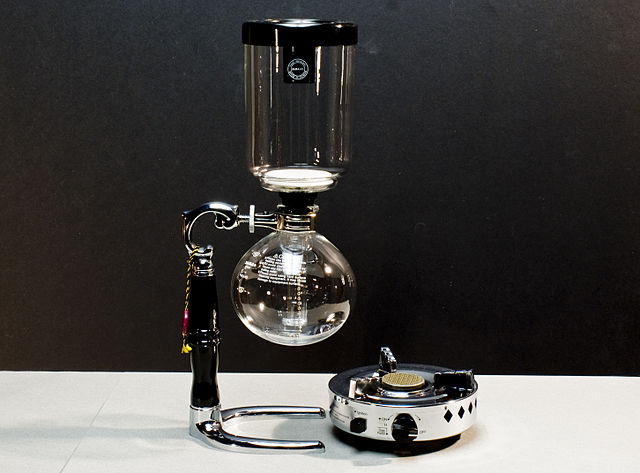
Like the name, siphon coffee maker will make you remember your chemistry laboratory days. It original one looks somewhat like an apparatus. However, the designs now are modified and look classy. If you are searching for the most common types of coffee makers for fine and delicate coffee, this is the best choice. Espresso lovers may not find this very efficient though.
Working Mechanism
Pour water into the lower compartment and put the ground coffee in the upper compartment. The concept is to brew the coffee beans with hot steam and not the water. The steam or vapor moves upwards and encounters the beans. The steam cools down to the water and combines with the beans. Due to the formation of a vacuum, the water moves back to the lower compartment. This increases the aroma and flavor of the coffee. The brew is appropriate for people who love aromatic and flavorsome coffee over strong ones.
Pros
- It has a very gentle method of brewing.
- It is best known for making aromatic coffee.
Cons
- Cleaning the parts of coffee makers can be hectic.
- Controlling the temperature is a challenge, especially in the non-electric versions.
Turkish Coffee Maker
This brewing method is very famous in Turkey. Moreover, many countries in the Middle East and Greece specifically use this coffee maker to brew coffee. The coffee maker is a beautiful and unique small pot used on a stovetop. The pot is known as cezve in Turkey and ibrik in other areas.
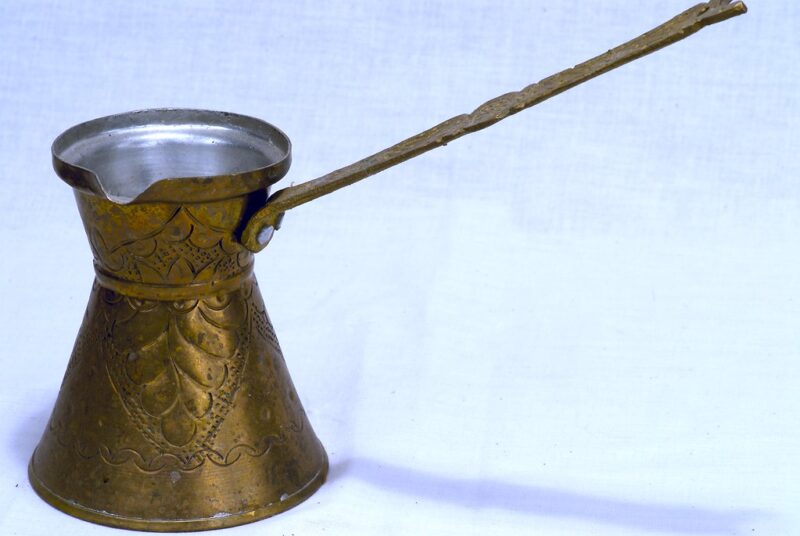
The brewed coffee is not only dark and strong but an unfiltered one. You can add seasonings or sugar as per your taste.
Working Mechanism
The mechanism is simple cooking. Take finely ground coffee in the pot and add water to it. Boil on the stove and transfer the coffee into a cup. The ground coffee generally deposits to the bottom. This is the best option for people addicted to very strong coffee.
Pros
- It has a very gentle method of brewing.
- It is best known for making aromatic coffee.
Cons
- You have to estimate the correct time of removal from the heat source. Over boiling will destroy the taste of coffee.
- The grounds are left behind in the cup that can sometimes enter into the mouth.
Coffee Percolator
Percolators are age-old coffee makers. These coffee makers existed until the invention of drip coffee machines. This is prevalently called the coffee pot. People in the USA used these pots to make coffee. A percolator encompasses a pot, a funnel, and a basket. The old percolators are used on a stovetop. However, the newer versions are electric.

Percolators make coffee, which is aromatic and flavorful.
Working Mechanism
The coffee maker is very easy to use. Water from the pot moves to the basket forcefully via a funnel. Accordingly, the water percolates back to the pot and the process goes on repeating. The perk of this coffee maker is that you can opt for gentle as well as the bitter brew.
Pros
- You will get strong aromatic coffee.
- The process of brewing is fast.
- The coffee is indeed a hot one without any doubt.
Cons
- It is difficult to control the temperature in the stovetop ones.
- If the brewing time is not noticed carefully, it may result in a bitter taste. Some people do not like the bitter version.
Grind and Brew Coffee Maker
We buy pre-ground coffee from the market for making coffee. However, the fresh ground coffee has a separate quality and taste that cannot match with the packed one. Sometimes, we even buy a grinder for this purpose. But what if you get a grinder along with a coffee maker?

The grind and brew coffee maker comes with an inbuilt coffee grinder. Therefore, it actually serves as a two-in-one apparatus- grinder as well as a coffee maker. The method used in these coffee makers is similar to dripping but with a twist of grinding.
Working Mechanism
Firstly, there are two types of Grind and Brew Coffee Maker based on the type of grinders. On one hand, you can find blade grinders while Burr grinders on the other. Most of these grinders are made of steel and are long-lasting. The blade grinders are more like chopping blades. In other words, they chop the coffee beans and thus make coarse grounds. The burr grinders have two hard materials that technically smash the beans into finer grounds.
Whatever the ground maybe, they accumulate directly in the brew basket after the grinder. Then add water to the water tank and follow the preset functions and your coffee is ready in the carafe.
Pros
- You can get the flavor of freshly ground coffee.
- There is no need for an additional grinder machine.
- You can store coffee beans in the storage section.
Cons
- Sometimes, the grinder is blocked due to ground coffee.
- These coffee makers require frequent washing and cleaning.
Single-Serve Capsule Coffee Maker
Single-serve coffee machines offer handy, quick, and premium techniques to brew a daily single cup of coffee. If an auto-drip coffee maker is convenient for you, this one will surely woo you. It has in fact replaced the drip coffee maker for better options. Keurig was the first one to develop such a masterpiece. Only a single touch and your coffee is ready in two minutes.

Working Mechanism
The mechanism is similar to the automatic drip mechanism. Put the amount of previously ground coffee appropriate for single use. There is a water reservoir to store water. The preset heating water options allow the hot water to combine with the ground. Therefore, the coffee is your cup even without doing anything.
Recent models are without any water reservoir. Consequently, they are light and are portable in nature. Moreover, the detachable tray helps to remove the ground residues easily. Hence, it has very low maintenance.
Pros
- This is perfect for a single cup of coffee.
- The brewing time is fast.
- You can make a variety of coffee drinks, the gentle as well as the bitter ones.
Cons
- The capsules are not recyclable.
- The capsules can be expensive sometimes.
Vietnamese Coffee Maker
Though not widely known, Vietnamese Coffee Maker is one of the most common types of coffee makers. It is the smaller version for Pour-Over Coffee Maker. it is generally made of steel.
Working Mechanism
The coffee maker is put on a mug where the coffee is to be collected. The water passes through the ground coffee and accumulates in the cup. As the name suggests, it is widely used in Vietnam. The brew is usually taken with condensed milk which is already present in the collecting mug.
Pros
- It is small and very easy to handle.
- As it is small and has no water reservoir or similar things, it is portable in nature.
- Cleaning and maintaining are very easy.
Cons
- Brewing time is higher in comparison.
- It can serve only one person at a time.
Steeped Coffee
Stepped coffee uses the method of steeping. Although it is not a coffee maker machine with huge technologies, it is obviously an effective one. Steeped coffee comes in pouches similar to tea bags. Moreover, the baggies are biodegradable, and disposing of them will not affect the environment.

Working Process
Take a mug of hot water. Add a coffee bag to it and allow it to steep for 5 minutes. Enjoy a full-bodied mug of coffee.
Pros
- Steeped coffee is portable. It can be carried from one place to other in a small purse also.
- You can choose between gentle or bitter coffee by controlling the steeping time.
- All you need is hot water in a mug which is almost available everywhere.
Cons
- Steeped coffee is not available easily.
- It serves only one person at a time.
The Bottom Line
Every coffee maker has Pros and Cons. Hence, the selection of the coffee makers largely depends on the type of coffee you love to have. Furthermore, space is an important aspect. If you do not have enough space, a bigger one cannot accommodate. On the other hand, if you are more into traveling, it is always better to switch to a portable one.
The most common types of coffee makers are readily available and you can order them anytime. Therefore, if you are willing to buy one, our article is definitely going to help you a lot.


